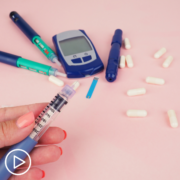What Can MPN Patients Expect When Starting a New Treatment?
What Can MPN Patients Expect When Starting a New Treatment? from Patient Empowerment Network on Vimeo.
What can myeloproliferative neoplasm (MPN) patients expect when starting a new treatment? Dr. Naveen Pemmaraju shares advice about potential issues that can occur and key points to discuss with your pharmacist to ensure optimal care.
Dr. Naveen Pemmaraju is Director of the Blastic Plasmacytoid Dendritic Cell Neoplasm (BPDCN) Program in the Department of Leukemia at The University of Texas MD Anderson Cancer Center. Learn more about Dr. Pemmaraju, here.
Related Programs

|

Why You Should Speak Up About MPN Symptoms and Treatment Side Effects |

Expert Perspective: Promising Myelofibrosis Treatment Research |
Transcript
Katherine Banwell:
We have a question from a newly diagnosed PV patient. Sharon says, “I’m just about to begin Jakafi. What can I expect?”
Dr. Pemmaraju:
Yeah, great question, right? So, with ruxolitinib or Jakafi, I think the biggest couple of points here is, for what’s known, this is the first-in-class JAK inhibitor that we have the most experience with.
So, now we have over a decade-plus of experience. I guess general things are general, right? This is not specific medical advice. That’s not the intention of this program. But, in general, I would stick with what’s on the package label insert, and there are a couple things we know.
One is this is a highly effective drug. This drug, which we have tested now in multiple, multiple, multiple different trials in myelofibrosis, polycythemia vera, now approved in a form of graft-versus-host disease, different doses. So, I would say check the dose for your particular disease and indication. Double-check it with your pharmacist. Make sure there are no drug-to-drug interactions.
Number two, I think what’s important is that some patients on this drug can experience immunosuppression. So, that means that you may be at risk for some infections, and there’s some nice literature about that.
So, check with your doctor about that, particularly reactivation of old infections, looking out for viral infections, such as herpes zoster or shingles. And then I think the other key here is to watch out for the modulation of your disease. So, a lot of folks have big spleens, Katherine. Those shrink down. Then patients get their appetite back, they’re able to eat, and so some people can have weight gain that then goes the other way. So, these are some of the things you want to watch out for.
But, in general, read the package insert. If you have the ability to, it’s worth reading the – if you can, read the paper, right? Go read the New England Journal paper or – if you can look at that. And then make sure you talk to your local pharmacist and ask the same question there. You might be surprised at some tidbits and pearls you can pick up.



